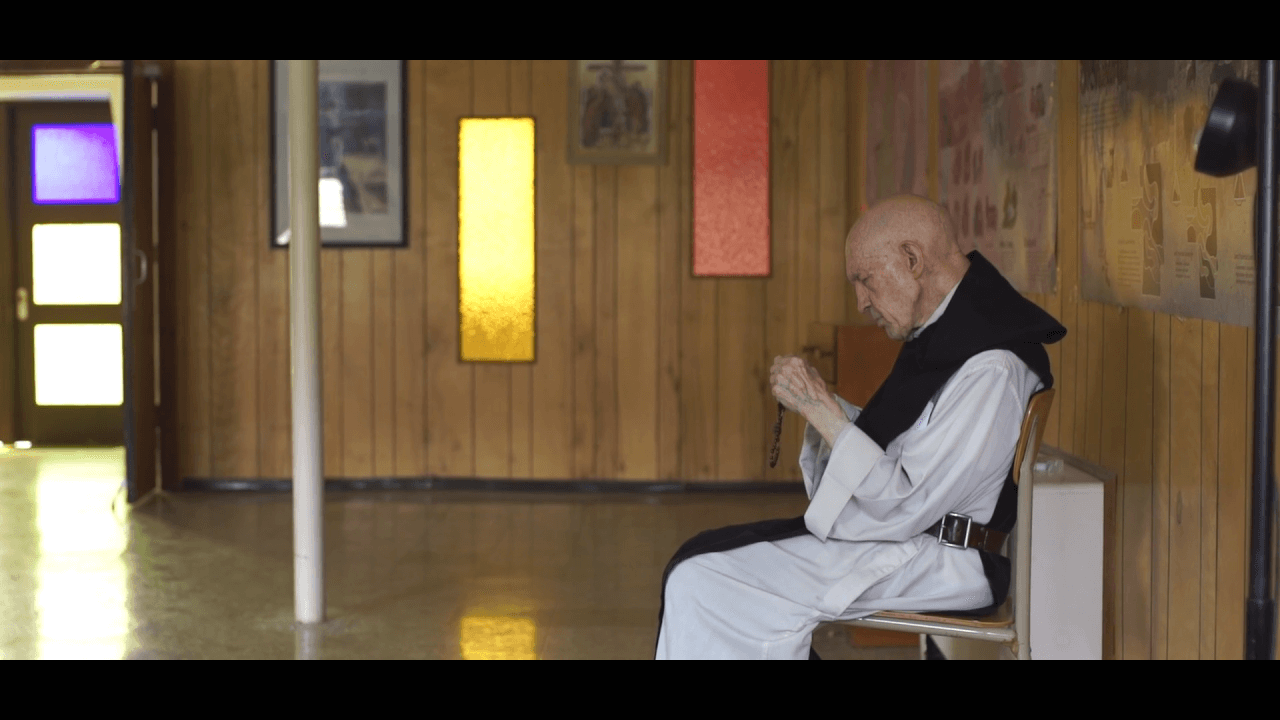Today I watched a short but moving video about a Trappist monastery in Huntsville, Utah, that was founded at the close of the Second World War. Once filled with 84 monks, it has now dwindled to only handful, who are being forced to leave because there are not enough of them — in good enough health — to keep the place going.
When one of the older monks, stooped over and at one point seen shuffling about his room with difficulty, is asked, “Where are you going next?” he responds, pointing upward with a laugh, “Heaven.”
Photographs are shown of the monastery during better days, monks eating together in community, doing manual labor, and offering the traditional Latin Mass. “You should have heard this choir,” the elderly priest says, “when it had 84 monks in it!”
Bright, black and white images of choir stalls laden with music during a High Mass filled with religious are replaced by a dark, empty church with a few laity attending a Novus Ordo Mass under a large, garish stained glass window not seen in the earlier photos.
Another monk, who gives the impression of being the prior (without being identified as such), tells the interviewer, “We’re in the process of trying to determine what this Church will be used for. If it’s not used for anything it’ll probably be torn down.”
“What’s it feel like to close a monastery?” He says. “It is very sad. But they say there’s a monk in everybody. Because there’s a desire for completion, for fulfillment….there’s an emptiness that calls out to be filled.” Later, he simply sums up the situation by saying, “So anyway, that’s…that’s where we are…” before looking at his watch, as though he has somewhere else at that moment that he needs to be.
I couldn’t shake the feeling that the video is a heartbreaking metaphor for the Catholic Church itself. By the end, I had tears in my eyes. It is a tragedy:
Watching this, I could not help being reminded of what Hilary White wrote yesterday about what has become of religious life in much of the world:
My conversation with the Important Monastic Personage came as the Catholic world received the news that yet another great, ancient, monastic tree has fallen. Vatican Radio reports that the Cistercian Abbey of Himmerod, founded in 1134 by St. Bernard of Clairvaux[3], will close. The 900-year history of Himmerod ends ignominiously with a dull thud: “The monastery’s property, near the village of Grosslittgen, will be transferred to the Catholic diocese of Trier, while the six monks will move to other monasteries.”
I’m afraid this news elicited from me not much more than a shrug. There is always a good reason when a great tree falls. I don’t know this one in Germany, but I’ve visited quite a lot of monasteries in Europe – mainly in Italy and Britain – and it’s always the same disease present in nearly all of them; the symptoms are spiritual apathy, indifference, a paralysing acedia[4]. If this old German tree has finally fallen, an examination of the carcass will invariably reveal extensive rot; there is usually little left of the heartwood[5].
In Italy the failure of the Novus Ordo “new springtime” to revive – or even to minimally sustain – monastic life is perhaps more palpable than anywhere else, because monasticism was omnipresent here. Every town of any size has its monastery of Benedictines or its house of Poor Clares and often Dominican or Carmelite convents all at the same time. Monastics are still revered by the local laity, but once inside what do we find? The architecture is still there; delicate stonework and frescoes – often of extreme antiquity – are painstakingly preserved usually with considerable help from the Italian government. Yet, while cold stone is conserved, in the monastic communities themselves, the great living organs of monastic life — the breath, blood, and heart that gives life to the community: the liturgy, the Chant, the vita communis, the single-minded pursuit of the Summum Bonum — are barely shadows of their former reality.
Visiting such places, you always get the same kind of response if you dare to ask how vocations are going; a kind of dull resentment that “young people can’t commit these days” and a blank, incomprehending stare if you ask, “Commit to what?” In those houses still clinging to life, the purpose of monastic life has simply faded away, attention turning to “social projects,” experiments with permaculture gardening, concerts, lectures, crafts and art history.
Lord, please save your Church.


